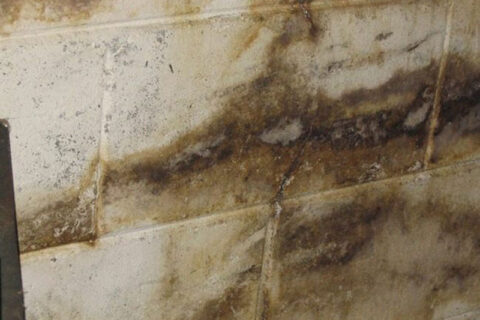The Mysterious White Stuff: What Is Efflorescence?
Everdry Waterproofing provides white mold removal services to residents throughout Milwaukee, WI and surrounding areas. We can help with white mold in basement, white mold on walls, and white mold on concrete. But have you wondered, what is that white stuff on your concrete or masonry block wall? It can be just a white powder on your concrete, salt-like crystals, white fuzzy stuff, or what looks like white stalactites growing on your concrete wall. These white deposits happen when water is drawn out of cement material. It is called efflorescence, and it’s not actually mold.
Efflorescence: The White Fluffy Mold on Concrete
Efflorescence is a scientific reaction. You will commonly see primary efflorescence initially during the curing process. When concrete cures, the water is naturally drawn out, and a sort of salt is left behind. Different admixtures can prevent this from happening, but efflorescence at this stage is usually not a problem. After the concrete is cured, secondary efflorescence can occur if there is a water problem present. This happens after the concrete is established. This is when efflorescence is usually more than a white powder. Most people confuse secondary efflorescence with mold because it looks like a white, dusty mold growing on your concrete. However, it is not mold but rather an indication of a water problem at hand—and where there is water, there is mold and potential structural damage.
Can Efflorescence Be Removed?
You can remove efflorescence with phosphoric acid, but that won’t prevent that water problem. If you see efflorescence, water is trapped inside your block or concrete wall. If water is trapped inside the foundation, spalling, scaling, or cracking can happen in the future. Spalling is when the concrete begins to crumble and break apart. Spalling will weaken the concrete wall and, ultimately, the entire structure. This is why we don’t use water repellants on both sides of the wall because it’s important not to trap moisture inside the wall.
How Do I Remove Efflorescence From Concrete Block Walls?
There are various ways to remove efflorescence, but the best way to do so depends on the surface and the composition of salts. When removing efflorescence from concrete block walls, the first step is collecting the necessary tools. These tools should include a bucket of warm water, liquid dish soap or cleaning vinegar, a paintbrush or automatic scrubbing brush, a dry cloth, protective goggles, and a fan. The second step is to make a mixture of soap and warm water. You’ll need to use a bucket containing about five gallons of water and add a few drops of the liquid dish soap. Whatever type of brush you opt for, scrub the wall with it. Then, drip the brush into the soapy water and scrub the wall again. The third step is to use fresh water after using the mixture. The wall should be rinsed with plain water and no soap. Step four is to use the fan to dry the wall. Step five is to clean the wall with a strong chemical product in case of an intense layer of efflorescence.
What Causes Efflorescence?
Efflorescence occurs when water containing dissolved salts is brought to the surface of masonry. The water eventually evaporates, leaving the salts on the masonry’s surface. Efflorescence happens with more porous materials like brick. It is common to see a brick wall almost turn all white from efflorescence. Water runs through the cement block or brick and pulls out the salt deposits.
How Can I Prevent Efflorescence?
Some of the same waterproofing techniques and water diversion systems work to prevent efflorescence. Because when you prevent water intrusion, you prevent efflorescence. Efflorescence is just a symptom of the real problem. You don’t want to just treat the symptom; treat the real problem and waterproof your foundation walls. Install a complete basement waterproofing system. Maintain your gutters and downspouts. Have proper drainage in your yard and around the perimeter of your house. If you have water trapped in your wall, efflorescence is the least of your worries. Take care of the water problem before it causes serious structural problems.
Is Efflorescence Harmful?
Efflorescence is not harmful or dangerous. Efflorescence, however, is often mistaken for mold, which can harm one’s health and is dangerous. Efflorescence, on the other hand, can lead to potential moisture problems, resulting in structural damage to building materials. Because of the damage that can result, acting when you notice efflorescence on a structure is important.
Can Mold Grow on Concrete?
Yes, mold can grow in or on concrete.
Contact Everdry Waterproofing About Efflorescence
If you’ve noticed efflorescence—often mistaken for ‘white mold’—at your property, reach out to the professionals at Everdry Waterproofing. We can remove any efflorescence at your home. Contact us today to request a free quote or to learn more about the services we offer our valued customers.
Ready to Get Started?
Contact Us Today to Schedule a No Pressure, No Obligation, Free Quote!

